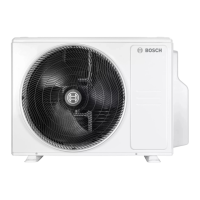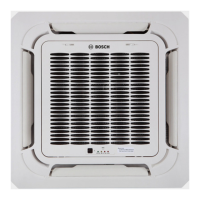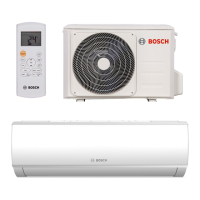Why is dust emitted from my Bosch Air Conditioner?
- MMegan DawsonSep 10, 2025
The Bosch Air Conditioner may accumulate dust during extended periods of non-use. This can be mitigated by covering the unit during long periods of inactivity.

Why is dust emitted from my Bosch Air Conditioner?
The Bosch Air Conditioner may accumulate dust during extended periods of non-use. This can be mitigated by covering the unit during long periods of inactivity.
Why does the indoor unit of my Bosch Climate 5000 AA make noises?
The indoor unit of your Bosch Air Conditioner might make a rushing air sound when the louver resets its position. Also, a squeaking sound may occur after running the unit in HEAT mode due to expansion & contraction of the unit’s plastic parts.
Why does the indoor unit of my Bosch Climate 5000 AA emit white mist?
In humid regions, a large temperature difference between the room’s air and the conditioned air can cause white mist to be emitted from the indoor unit of your Bosch Air Conditioner.
Why do both indoor and outdoor units of my Bosch Climate 5000 AA emit white mist?
When your Bosch Air Conditioner restarts in HEAT mode after defrosting, white mist may be emitted from both the indoor and outdoor units due to moisture generated from the defrosting process.
| Type | Split Air Conditioner |
|---|---|
| Refrigerant | R32 |
| Power Supply | 220-240V, 50Hz |
| Features | Sleep Mode |
| Wi-Fi | Yes |
Explains warning symbols and keywords like DANGER, WARNING, CAUTION, and NOTICE used in the manual.
Covers critical safety information for installation, product use, electrical hazards, cleaning, and general operational cautions.
Identifies the main components of the indoor unit, including filters, louvers, display window, and controls.
Details optimal operating temperature ranges for COOL, HEAT, and DRY modes for efficient performance and identifies factors for optimization.
Explains features like Auto-Restart, Anti-mildew, Louver Angle Memory, and Refrigerant Leakage Detection.
Provides instructions for adjusting the vertical and horizontal airflow direction using the louver controls and SWING/DIRECT button.
Describes the SLEEP function for energy saving, detailing temperature adjustments and automatic shut-off after 7 hours.
Provides instructions for manual operation using the control button on the indoor unit in case of remote control failure.
Details essential precautions before cleaning, including electrical safety, avoiding specific chemicals, and using appropriate water temperatures.
Step-by-step guide on how to remove, clean, and dry the air filters, including optional air freshening filters.
Explains the 'CL' and 'nF' indicators for filter cleaning and replacement, and how to reset the reminders.
Outlines the steps for preparing the unit for extended periods of inactivity, including cleaning and power disconnection.
Lists recommended checks before periods of frequent use, such as wire inspection, cleaning, and leak checks.
Addresses common operational issues, their possible causes, and solutions without requiring repair services, including noise and mist explanations.
Details the requirement for qualified personnel to recover refrigerant and proper disposal of recyclable components for environmental protection.











